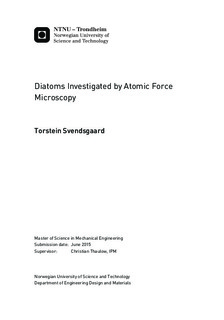Diatoms Investigated by Atomic Force Microscopy
Master thesis
Permanent lenke
http://hdl.handle.net/11250/2350260Utgivelsesdato
2015Metadata
Vis full innførselSamlinger
Sammendrag
Diatoms are microscopic algae which have a complex outer cell wall(frustule) made up by silicon dioxide and organic proteins, collectively called biosilica. The mechanical properties of the diatom frustule have been a popular area of research in recent years. The biosilica seems to be outperforming human pro- duced fused silica in terms of strength. The morphology and mechanical prop- erties of the diatom Coscinodiscus sp., examined by atomic force microscopy, is reported in this thesis.
The frustule is made up by three layers, where it have been found a decrease in pore size from the inner to the outer layer. The mean pore diameter was determined to be 832±133nm, 447±73nm and 72±12nm for the inner(foramen), mid(cribrum) and outer(cribellum) layer, respectively. Cleaved frustules have also been investigated, where a layered structure of the biosilica was observed.
The mechanical properties of the diatom frustule have been examined by a novel AFM method, Peak Force Quantitative Nanomechanical Mapping, where the elastic modulus of the sample is mapped. Young s modulus was determined to be 27 ± 4.2GPa and 25 ± 3.2GPa for the foramen and cribellum layer, re- spectively. A slight decrease in elastic modulus was found towards the edge of the frustule on the inner layer. An interesting characteristic was found, namely a decrease in Young s modulus of the material surrounding the larger pores in the inner layer.
The reported results indicates that the biosilica is a layered composite material, where local variations in material properties are observed.
